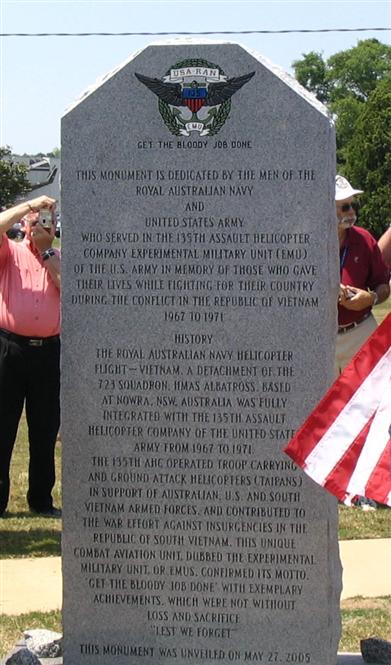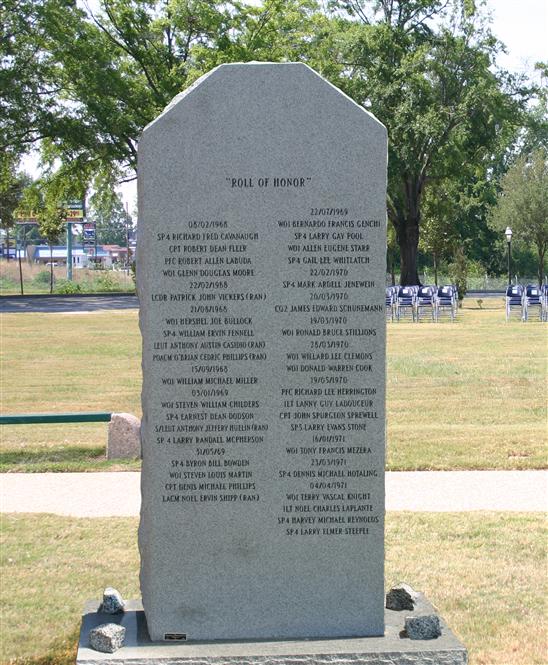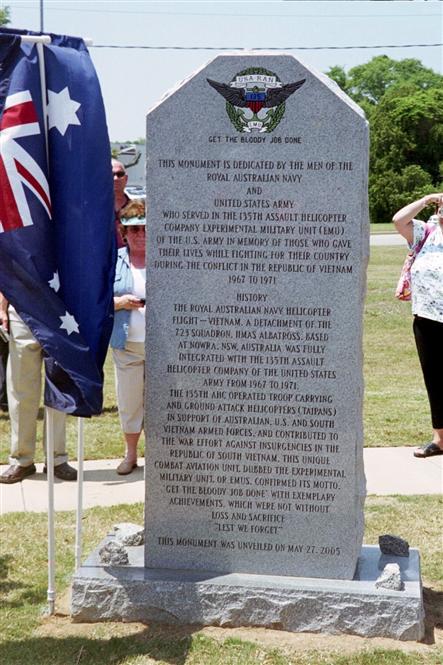The 135th AHC (EMU) US Army Royal Australian Navy Memorial
Description
A granite monolith with the dedication and history written on the front and the Roll of Honour on the back.
Photographs courtesy of Keith Taylor
History
In December 1966, the United States Government requested Australian assistance to meet the need for additional air crew and maintenance personnel. The Australian Government offered a detachment from the Royal Australian Navy's Fleet Air Arm (RAN FAA), named the Royal Australian Navy Helicopter Flight Vietnam (RANHFV). The first RANHFV contingent reached Vietnam on 16 October 1967 and until June 1971 remained fully integrated with the US Army 135th Assault Helicopter Company (AHC). The role of the 135th was to provide tactical air movement of combat troops, supplies and equipment, known as air-mobile operations. Due to the unique relationship between the RAN and the US Army, the unit was designated by the 135th as an Experimental Military Unit, using the acronym EMU after the large, fast, and highly mobile Australian bird, to the amusement of the Australians as the emu cannot fly. During its four-year deployment to Vietnam, over 200 RAN FAA personnel had rotated though the RANHFV in four contingents and performed its mission from five separate bases in Vietnam. The unit flew hundreds of offensive operations and was involved in some of the most intense combat experienced by Australians in the war, earning not only the aviators but also the maintenance and support staff a reputation second to none.
Initially based at Vung Tau, EMU’s first mission was on 3 November 1967. Two months later, in late December, the unit moved from the secure base of Vung Tau to the American base at Black Horse in Long Khanh province. Set amidst rubber plantations and jungle, the base was dangerously vulnerable to rocket and mortar attack. In November 1968, the 135th was reassigned to Camp Martin Cox at Bear Cat in Bien Hoa province and, as with Blackhorse, Bearcat was also subject to attacks and frequent perimeter incursions from the enemy. The unit moved again, in September 1970, to Dong Tam in South Vietnam’s Mekhong Delta, supporting strictly Vietnamese Army units. As other aviation units in the Delta deactivated, the only US/Australian helicopter unit in existence took up the slack. Early in 1971, having moved to Di An, it was announced that the RANHFV would be withdrawn from Vietnam and on 8 June the RAN portion of the 135th ceased operations and was replaced by US personnel, marking the end of the joint-force Experimental Military Unit. Five members lost their lives in Vietnam and some 22 were wounded in action, the highest casualty rate of any RAN unit in Vietnam.
The gallantry and distinguished service of RANHFV members was recognised by the award of three Member of the Order of the British Empire Medals (MBE), eight Distinguished Service Crosses (DSC), five Distinguished Flying Crosses (DFC), one British Empire Medal (BEM), several Vietnamese and United States decorations, thirty four received Naval Board Commendations and twenty-four were Mentioned-in-Dispatches.
Construction Information
No information available at this time.
Location
Fort Rucker, United States of America.
Fort Rucker is a massive air-base and the home of the 1st Aviation Battalion US Army. It has three entrances and access can be gained from the towns of Enterprise, Ozark and Daleville.


